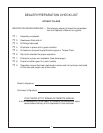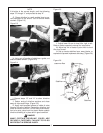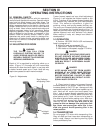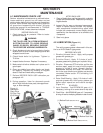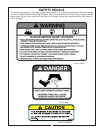
4-3 BLADE REPLACEMENT
Tiller blades should be replaced when they have
approximately 1/4” of wear left on tip of blade.(Figure
4-7) To replace blades, remove bolts securing blade.
Install new blade in its place. Blade must be a right
or left corresponding to the blade removed. Pay spe-
cial attention to the bolts on the blades; the bolt head
must be placed on the blade side, with the washer
and the nut on the flange side so that the bolts can-
not loosen while the equipment is being used. When
several blades must be replaced, replace one blade
at a time, so that the initial layout is maintained.
(Figure 4-8) Tighten blade bolts to 70 ft. lbs. Use
only genuine Bush Hog replacement parts.
WARNING
THE TILLER CAN FALL FROM
HYDRAULIC SYSTEM FAILURE. TO
AVOID SERIOUS INJURY OR DEATH,
SECURELY SUPPORT TILLER BEFORE
WORKING UNDERNEATH.
Figure 4-9
Clutch Spring Length
1-1/16”
(27mm)
12
4-4 SLIP CLUTCH OPERATIONAL
CHECK
After tiller has been stored for 30 days or more,
perform the following operational check:
A. Loosen eight nuts retaining clutch springs
exactly one full turn.
B. With tiller blades firmly on ground and tractor
at idle speed, engage tractor PTO drive for 2-3 sec-
onds. Clutch should slip without turning blades. If
clutch does not slip, contact your authorized Bush
Hog dealer.
C. Retighten nuts to within 1/64” of original position.
Initial spring length is 1-1/16” (27mm). (Figure 4-9)
4-5 SLIP CLUTCH ADJUSTMENT
The slip clutch is factory preset to the correct torque
for protecting implement and tractor. Periodic
adjustment is recommended; refer to Section 4-4.
Should adjustment be needed, first check to be sure
all spring lengths are within 1/64” of being the same.
Initial spring length is 1-1/16” (27mm) shown in
Figure 4-9. If necessary, loosen nut on any spring
that is unequal. Adjust all eight spring retaining nuts
2/3 of a turn (2 flats on a nut) and check clutch slip-
page. If further adjustment is necessary, do so in 1/3
turn increments or consult your Bush Hog dealer.
Adjust only to provide sufficient torque to prevent
slippage under normal conditions. When rocks, roots,
etc. are present, occasional slippage is normal for
drivetrain protection.
CAUTION
FAILURE TO RETIGHTEN SPRING NUTS
TO ORIGINAL POSITION MAY CAUSE
DAMAGE TO TILLER AND/OR TRACTOR
DUE TO IMPROPER SLIP CLUTCH
TORQUE SETTING.
Figure 4-7
Bolt Head
Against Blade
Figure 4-8
Helical Arrangement
1/4” Minimum



